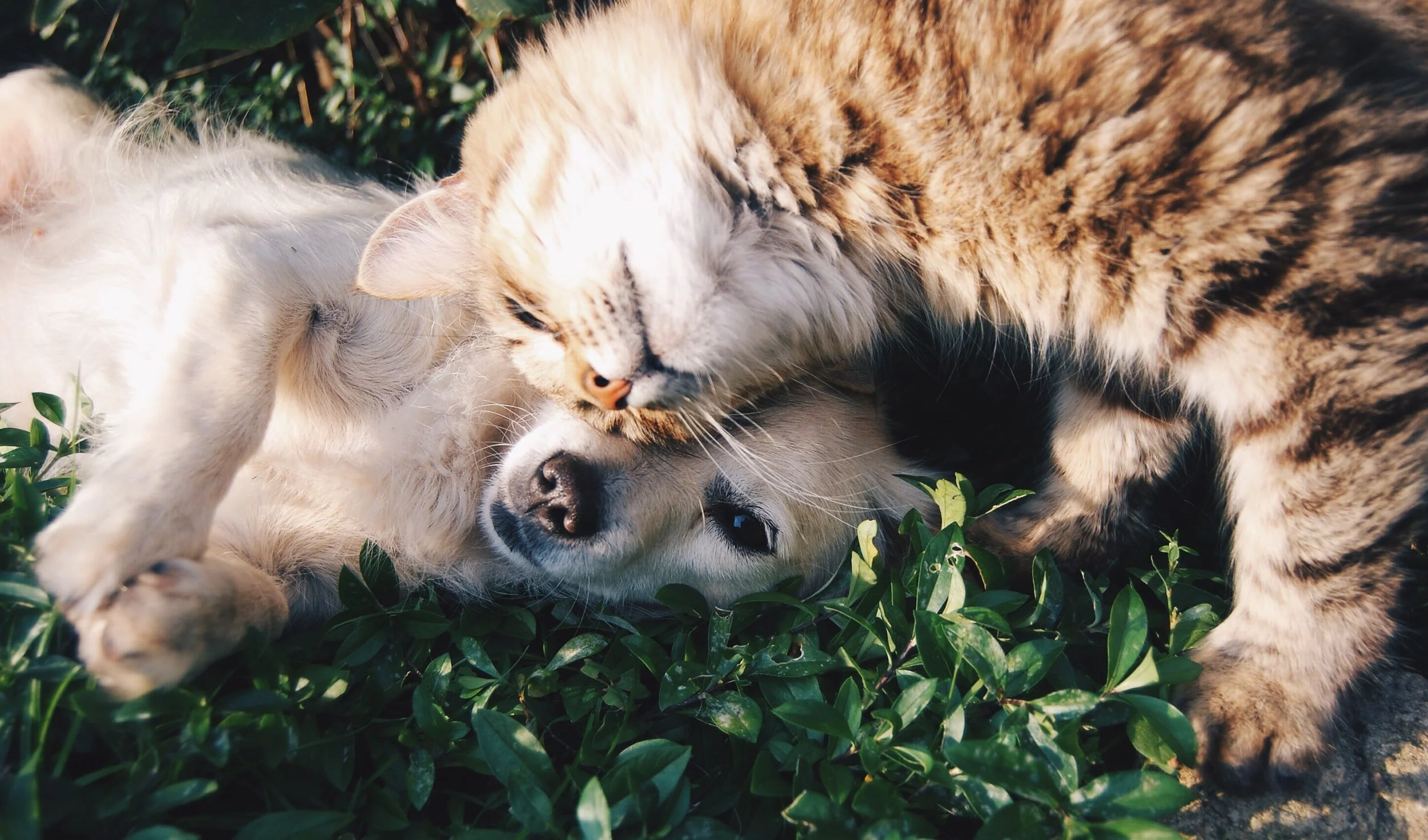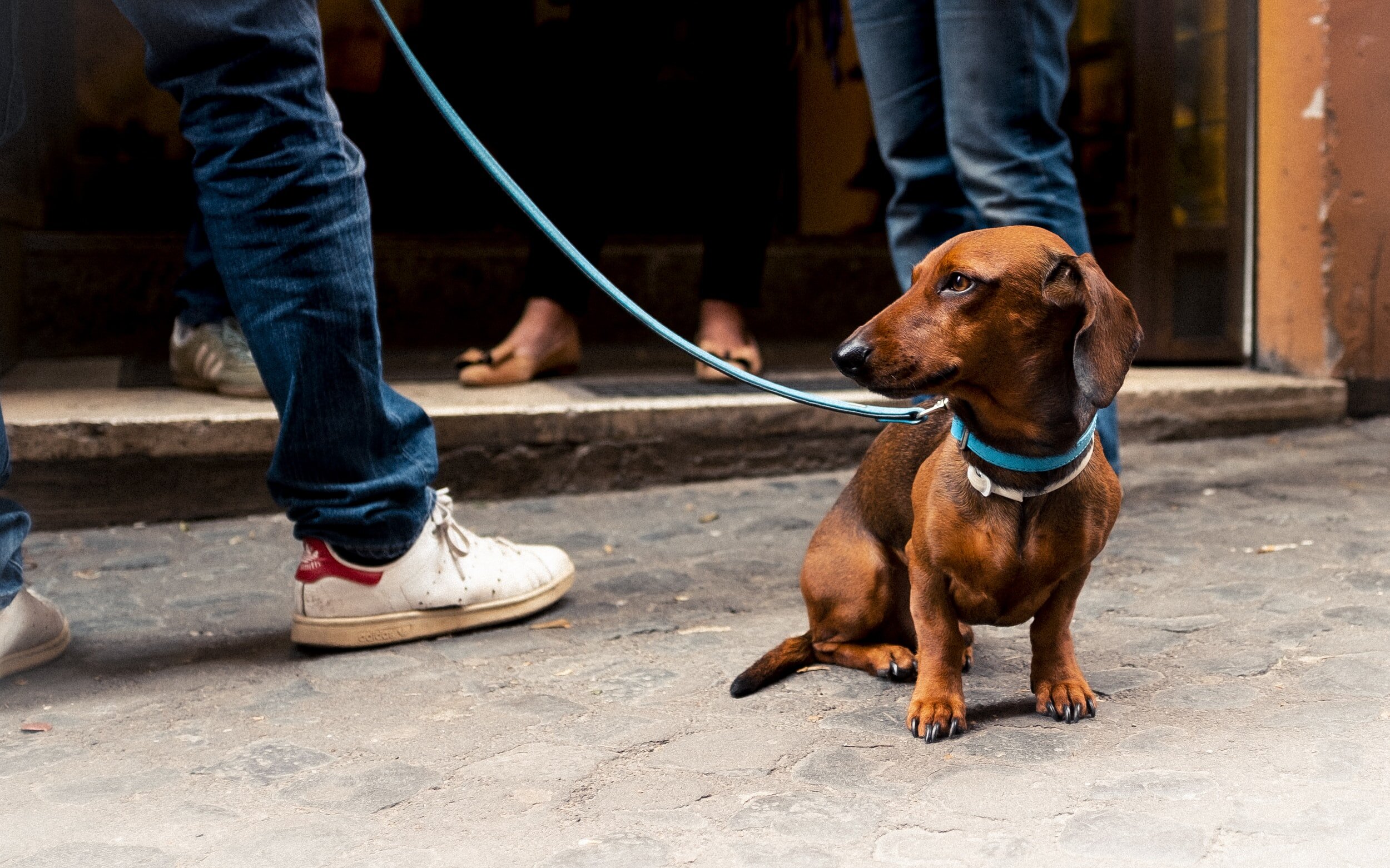Even if your dog is trained in bite-work or other protection sports, it’s not his job to keep other dogs away from you while you’re out and about in public. That’s your job. (Photo: A mastiff who is likely working on bite-work with a man and a woman)
This week, we’re continuing on our journey to learn more about what to do when walking our own dog on a leash and we come across off-leash dogs.
As you know from reading last week’s post, dog ownership is a massive responsibility and there’s a LOT we need to learn as responsible dog owners.
We need to learn how to see the world from our dog’s point of view, to better fulfill their needs. We need to understand dog body language, so we can assess situations and stay calm while doing so. We need to learn to provide leadership to our dogs, so they can trust that WE are capable of being charge when perceived threats (like off-leash dogs) are heading our way.
The more information you have, the better prepared you’ll be. The stronger your relationship with your OWN dog, the better prepared you’ll be.
If your dog is currently reacting to other on-leash dogs by:
-standing in front of you
-barking and growling
-lunging on leash
-yanking you off your feet
then he currently sees it as his job to protect you. This will certainly cause problems if an off-leash dog heads toward you.
Are you pulling back on the leash? This is sending your dog a clear signal that the other dog is a threat. All dogs have what is called opposition reflex — when someone pulls back on their leash, they automatically pull forward. This is put to good use with police canines who are taught to bite the person wearing the super padded “bad guy suit.” The police hold the dog’s harness, which stimulates that opposition reflex, allowing their working dog to get fired up at the “bad guy” before letting go.
See how it works?
The way most people open their front door. Just sayin’. (Photo: Person wearing army fatigues holding the collar of a German Shepherd, creating opposition reflex)
Are you accidentally sending your dog the wrong message? Are you pulling him back, telling him to get fired up at dogs, bikes, and strangers?
Do you also get nervous when you see dogs in the neighbourhood and think: “Here we go again,”?
Your dog will pick up on your nervous energy and act accordingly to keep the other dogs away from you. We don’t want that. It’s no fun to feel nervous all the time, and it’s super stressful for your dog to live on edge like that too.
So, if your dog shouldn’t be in front of you pulling on the leash, where should he be?
Great question.
In our popular culture, we think it’s amazing when our dogs step up in front of us and protect us. In fact, a growing number of my clients have selected dogs based on wanting to feel protected. The issue is that a dog who is not bred and trained to be a protection dog isn’t happy doing this job. Oftentimes, the dogs I work with are anxious (whine almost all of the time) and are much more confident and happy when they learn that their humans are in charge (inside and outside of the home, including on walks.)
When we invite a dog to live in our home and in the human world, it is our job to show them how to feel safe and protected. It’s our job to show them that garbage trucks are not scary, bicycles are not out to get them, and that other dogs in the neighbourhood are not threats to us.
So, where should your dog be when there’s a perceived threat?
Hint: The opposite of this…(Photo: A dog walks in front of her owner on a tense leash)
Behind you.
Like this while you’re walking…(Photo: A dog heeling beside his owner, looking up at his owner while moving forward.)
Getting closer…but this picture has too much leash tension. (A person stands in the snow with their dog behind their knees. The dog is wearing a halti and there is tension on the leash.)
More like this. (Photo: a person wearing a backpack standing on a tree stump looking off into the mist. There is a dog standing behind them in a heel position. The dog is looking up to them for direction.)
It’s your job as pack leader to deal with perceived threats. Perceived threats to one dog may be strangers reaching into their personal space to pet them. To another dog, a perceived threat is the delivery person who walks onto what your dog perceives as THEIR territory. To another dog, it’s a strange object, like construction equipment, a bag of yard waste, or Christmas decorations that move and make noise. Your job is to be in front of your dog to advocate for his space and to keep danger away.
My first opportunity to learn this lesson was a couple of decades ago. I had not yet heard of dog psychology. I was an accidental leader for my first rescue dog, because I just did what felt natural. I exercised him every day and I provided structure and boundaries and rules. Looking back, there were a lot of things I could have done better, had I known dog psychology, but Brooklyn and I did pretty well. Keep in mind, that when I owned Brooklyn, I lived, breathed, and sometimes even slept with dogs while working as a technician at the University of Guelph. I not only worked with dogs every day, I walked them in my spare time (during my lunch breaks.) Despite being surrounded by dogs 24-7, there were still LOTS of things I needed to learn.
The first time Brooklyn stepped behind me when faced with an aggressive dog, I thought it was because he was afraid of her. I also wrongly thought: “Wow. He doesn’t want to protect me. What have I done wrong? He must not love me at all.”
I now know what it means when a dog steps behind you in the face of danger.
What I didn’t realize back then was that I had earned Brooklyn’s TRUST and his RESPECT. When you have trust, respect, AND love, you have a balanced pack. You have harmony. And you’re actually way safer out in public, because the human is in the driver’s seat. Humans make wayyyyy better decisions than dogs. Dogs make quick, instinctual decisions to defend themselves. Hopefully after reading this, you’ll realize it’s your job to defend THEM, not the other way around.
Brooklyn and I lived in a big house divided into five apartments. One of the apartments was home to a vet student and her newly adopted two-year-old pitbull. This beautiful, grey pit was the leader of her human. She pulled her everywhere she wanted to go and she was walked on a flexi-leash that could snap at any time. This “pull my human everywhere I want” relationship combined with leash tension created leash frustration, reactivity, and eventually aggression.
Brooklyn and I came across them on neutral territory. We were strolling down the sidewalk, and they were in a small playground. They had higher ground and were partially blocked by the play structure, so we didn’t notice them right away. The pit took one look at us and went straight into the red zone. She shot straight for us (faster than anyone could have said a prayer to the God of flexi-leashes,) barking and snarling.
Brooklyn stepped behind my legs. I held my breath (because I didn’t have the knowledge I have now - breathe, friends, breathe!)
The flexi-leash held, jerking the poor dog backward, and unfortunately teaching her nothing except how to be more frustrated on the leash. She stood on her hind legs snarling, growling, and barking while her owner held on for dear life.
I’m grateful that Brooklyn believed I could handle that threat while holding nothing but a Kong-on-a-rope. He believed in me long before I believed in myself.
Brooklyn wasn’t a chicken. He wasn’t throwing me under the bus. And there was nothing “wrong” with our relationship. Brooklyn was letting me do what I did naturally for him every day: lead.
Brooklyn living his best life (Photo: author’s first rescue dog, Brooklyn, leaps off a dock after a ball)
A few tips so that you can lead your dog, so they can trust you in all of life’s tough situations:
-provide exercise every day (not as much as you feel like giving them, but the amount they actually need to be mentally and physically fulfilled every day)
-teach them a structured walk (from your dog’s point of view, if you are walking in the back, you are the follower. They need a leader.)
-wait for natural eye contact before going through doorways, up a set of stairs, and before giving any food
-build a strong foundation in the home, before falling into the “too much freedom too fast” trap
-acknowledge the effect your own energy has on your dog
-learn everything you possibly can about the way your dog sees the world (dog psychology)
If your dog isn’t trained as a personal protection dog (by a professional who knows what they are doing,) then it is not your dog’s job to protect you and your family.
Will they step up in the middle of the night to an intruder? Of course they will. But should they have to feel as though they need to defend you from oncoming dogs on the street: no.
You need to:
-protect
-direct
-love
Did this week stray wildly off-topic? The pitbull wasn’t off-leash, you say?
Flexi-leads snap all the time. Leashes fly out of people’s hands all the time. A dog can go from on-leash to off-leash in an instant. There was a post in our local online dog forum this week about a dog slipping out of his collar and attacking an on-leash dog. The dog who was attacked required veterinary care. Sidebar: The dog who attacked the other dog was a Golden Retriever. I feel the need to mention this as people so often believe that certain breeds are aggressive and others are not. No dog is born aggressive. Any dog can become aggressive. Always look at the human behind the dog.
The lessons for this week:
-It is your job to provide protection to your dog, not the other way around.
-You should stand in front of your dog to let them know you’re in charge (and if they already know you are their leader, they will step behind you.)
Next week: How to let an off-leash dog know they shouldn’t bother approaching you.
Have a safe and happy weekend, Dog Leaders!
Alyssa
Photos by: Upsplash (A mastiff who is likely working on bite-work with a man and a woman), Altino Dantas @altinodantas (Person wearing army fatigues holding the collar of a German Shepherd, creating opposition reflex.) Upsplash (A dog walks in front of her owner on a tense leash,) Upsplash (Photo: A dog heeling beside his owner, looking up at his owner while moving forward,) Upsplash (a person wearing a backpack standing on a tree stump looking off into the mist. There is a dog standing behind them in a heel position. The dog is looking up to them for direction.) Alyssa Foulkes ( author’s first rescue dog, Brooklyn, leaps off a dock after a ball.)
























































